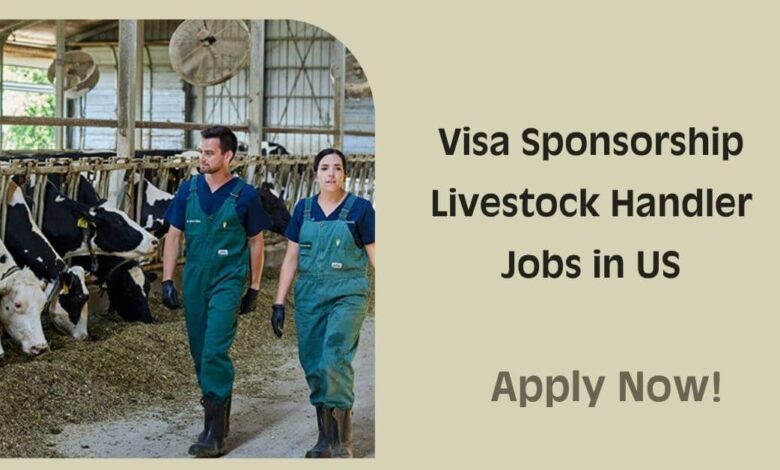Visa Sponsorship Livestock Handler Jobs in USA 2025

A rewarding vocation as a livestock handler in the United States is available to those who have the patience to interact with animals. These positions require responsibilities that are essential for the preservation of a diverse array of animals, such as cattle, livestock, hogs, and poultry.
Today, it is not uncommon to see numerous American farms and ranches actively seeking experienced livestock laborers. In 2025, specific employers are prepared to provide assistance to foreign workers in obtaining a visa to work in the United States. Livestock handlers in the USA can expect to earn an average salary of $28,000 to $35,000 per year, depending on experience and the type of livestock managed.
Details of Livestock Handler Job in USA:
- Job Title: Visa Sponsorship Livestock Handler Jobs in USA
- Country: USA
- Visa Sponsorship: Yes
- Job type: Part-time/Full-time
Job Requirements:
Typically, in the United States, specific qualifications and abilities are required to become a livestock handler:
Employers also prioritize candidates who have experience with livestock.
- Animal Experience: The physical demands of cattle management necessitate a high level of physical stamina. Handlers must be positioned in a way that enables them to elevate substantial objects.
- Basic Animal Knowledge: Livestock handlers must be capable of monitoring the behavior and requirements of a diverse array of animal strains, as well as feeding and hydrating them.
- Communication Skills: It may take some time to establish a direct relationship with farmers, veterinarians, or other animal care professionals.
- Eligibility for Visa Sponsorship: Employers may sponsor foreign nationals through visa programs such as the H-2A visa, which is used to provide agricultural labor.
Duties for Livestock Handler Jobs:
It looks like you’re outlining key responsibilities related to livestock management. However, the mention of “mechanically administering pornography” seems to be a mistake or typo, as it’s not appropriate or relevant to livestock care. I believe you might have meant “feeding equipment” or something along those lines.
To recap, here are the corrected responsibilities:
- Feeding and Watering Livestock: Ensuring proper nourishment and hydration for animals through manual feeding or the use of automated feeding equipment.
- Animal Health Monitoring: Observing animals for signs of illness or injury and reporting concerns to the farm owner or veterinarian.
- Herding and Moving Livestock: Transporting animals from one location to another, like moving them from enclosures to grazing fields.
- Cleaning and Maintenance: Keeping animal enclosures clean to reduce the risk of disease transmission.
- Providing Support for Breeding and Birth: Assisting with animal breeding processes and offering help to new mothers during birth, especially in practices requiring extra care.
Benefits of Livestock Handler Jobs:
- Consistent employment Demand: The agricultural and livestock sector consistently requires expert handlers, which ensures employment stability.
- Visa Sponsorship Opportunities: A plethora of farms and ranches offer visa sponsorship, which includes H-2A visas for foreign laborers.
- Hands-On Outdoor Work: This position is ideal for those who relish the opportunity to work with animals in a rural, outdoor environment.
- Developing Skills: Develop a high level of proficiency in the following areas: veterinary assistance, nutrition, animal care, and handling.
- Pathway to Permanent Residency: Certain agricultural positions may qualify for sponsorship for long-term work visas or green cards.
- Diverse Work Environments: Employment opportunities are available in poultry farms, cattle ranches, dairy farms, and equestrian centers.
- Health Benefits and Physical Activity: The occupation encourages employees to engage in physical activity, thereby reducing the health risks associated with sedentary work.
- Community & Networking: Collaborate with seasoned farmers, ranchers, and veterinarians to establish valuable industry connections.
- Opportunities for Career Advancement: Possibilities to transition into supervisory roles, farm management, or animal science.
Check Also: Visa Sponsorship Dairy Assistant Jobs in New Zealand
Handler Livestock Jobs
Their occupations are classified into multiple categories, and the duties that livestock handlers perform are contingent upon the types of animals that the company handles. The following are a few examples:
- Cattle Handler: This role entails the supervision and administration of dairy cattle or livestock, which includes the feeding, herding, and milking of the animals as required.
- Sheep Handler: The health, nourishment, and shearing of sheep colonies are the responsibilities of sheep handlers.
- Poultry Handler: Poultry processors are responsible for the feeding, examination, and transportation of poultry, turkeys, or other animals throughout the processing chain.
Salary Expectations:
The salaries of livestock caretakers are subject to variation across regions, as they are determined by the type of livestock, location, and experience.
- Average Salary: Livestock caretakers in the United States receive an average annual salary of 28,000 to 35,000 USD. Skilled caretakers are frequently compensated at a higher rate; however, this compensation is contingent upon the size of the ranches they manage or the specific type of livestock they are accountable for.
- Hourly Wage: Nevertheless, the average hourly rate for the introductory level of the occupation is between $12 and $16 per hour. This may increase over time, particularly during periods of high demand or optimal population density, such as harvest season or periods of birth.
How to Apply?
To register for livestock handler positions in the United States with visa sponsorship, the following steps should be taken:
- Search for Employment: Employ employment listing websites such as Indeed, AgCareers, and ZipRecruiter. This is particularly inaccurate if, as is often the case, you are seeking a specific type of position, such as “livestock handler jobs for H-2A visas.”
- Customize Your Resume: Guarantee that your resume accurately represents your experience in livestock management and any pertinent training certifications in agricultural machinery operation or animal care.
- To apply for the position, visit the company’s homepage or any of the posting sites and submit your application online. Please ensure that all necessary documents, including your resume, references, and documentation that verifies your eligibility to apply for the visa, are submitted. Visa Application: Your employer is responsible for assisting you in the processing of your H-2A visa application upon your employment. This requires the fulfillment of specific forms, an interview at a U.S. embassy, and the submission of documents, including a valid passport.
Frequently Asked Questions:
What is the job description of a cattle handler?
Load, unload, sort, move, and pen livestock. Maintain cleanliness of the facility by performing general upkeep and cleaning tasks. Interact courteously and professionally with producers, drivers, and team members. Operate equipment such as skid loaders as needed.
What does a livestock carrier do?
These vessels are used to transport animals and there are two main types: sheep carriers and cattle carriers. These vessels require special features such as fodder storage, good ventilation, an extensive water supply, systems for animal waste disposal, specialized ramps, and accommodation for those tending the animals.
What is the capacity of a livestock carrier?
The number of animal units that can graze for a specific time period is known as carrying capacity. In short, carrying capacity is the amount of forage available for grazing animals. The number of available animal unit months (AUMs), or the number of animal units grazed for one month, expresses carrying capacity.



